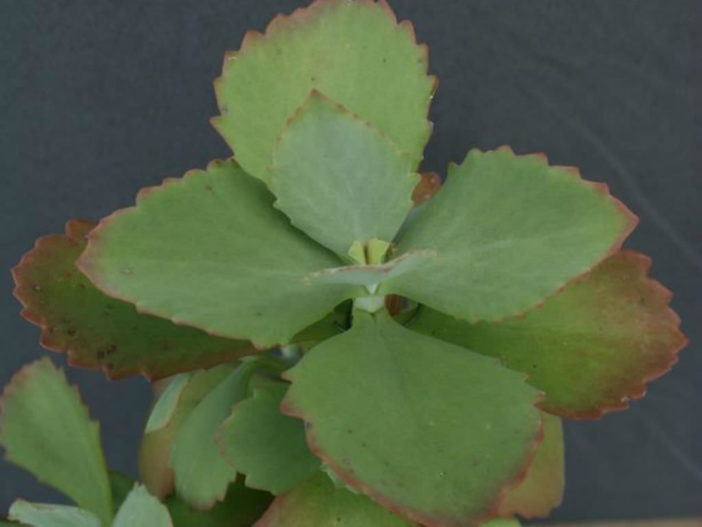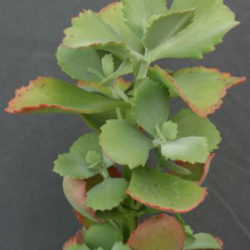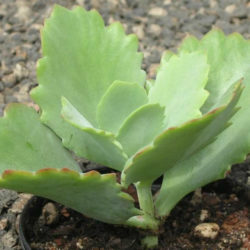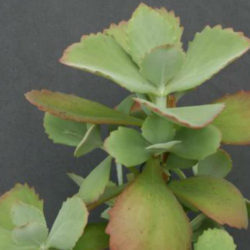Scientific Name
Kalanchoe longiflora Schltr. ex J.M. Wood
Common Name(s)
Long-flower Kalanchoe, Tugela Cliff-Kalanchoe
Scientific Classification
Family: Crassulaceae
Subfamily: Sedoideae
Tribe: Kalanchoeae
Genus: Kalanchoe
Description
Kalanchoe longiflora is a sparse succulent shrublet with 4-angled decumbent branches that bear grey-green leaves with thick bloom, often with pinkish to reddish margins or completely reddish-brown. The branches are fleshy but woody at the base and can grow up to 16 inches (40 cm) long. The leaves are shaped like a limpet shell with a sharp or rounded tip, a wedge-shaped base, and rounded teeth along the upper part of the margins. They measure up to 3.2 inches (8 cm) long and wide and are attached to the branches by a petiole up to 0.6 inches (1.5 cm) long.
The flowers are yellow to orange, up to 0.6 inches (1.5 cm) long, and appear in many-flowered corymbs in fall and winter.
The species is often confused with Kalanchoe sexangularis but can be easily distinguished by its quadrangular stems instead of the cylindrical or irregularly ridged of the latter.
Origin
Kalanchoe longiflora is native to South Africa. It grows on rock faces in the central Tugela River basin in KwaZulu-Natal province.

Hardiness
USDA hardiness zone 10a to 11b: from 30 °F (−1.1 °C) to 50 °F (+10 °C).
How to Grow and Care
Kalanchoe care is minimal, but be cautious about light levels. Intense sunlight can burn the tips of the leaves—place pots in partial sun to light shade areas when growing Kalanchoes.
The flowering varieties are highly rewarding for their colorful and long-lasting flowers. They prefer bright, sunny locations, especially in the growing season. Water moderately from fall to winter when the growth is most active. Reduce watering during the hottest summer months when the plants are mostly dormant and winter when the growth slows significantly. Let the soil surface dry out between waterings. Watch the fleshy leaves for signs of water distress. An ordinary potting soil mix is fine. Feed bi-weekly during the growing season with a liquid fertilizer, or use slow-release pellets.
These small plants require repotting every few years. When repotting, take additional care in handling as the leaves are somewhat brittle and can snap easily. Clay pots work exceptionally well for planting Kalanchoes. Ensure pots can drain well and saucers can empty easily.
Learn more at How to Grow and Care for Kalanchoe.
Links
- Back to genus Kalanchoe
- Succupedia: Browse succulents by Scientific Name, Common Name, Genus, Family, USDA Hardiness Zone, Origin, or cacti by Genus
Photo Gallery
Click on a photo to see a larger version.


